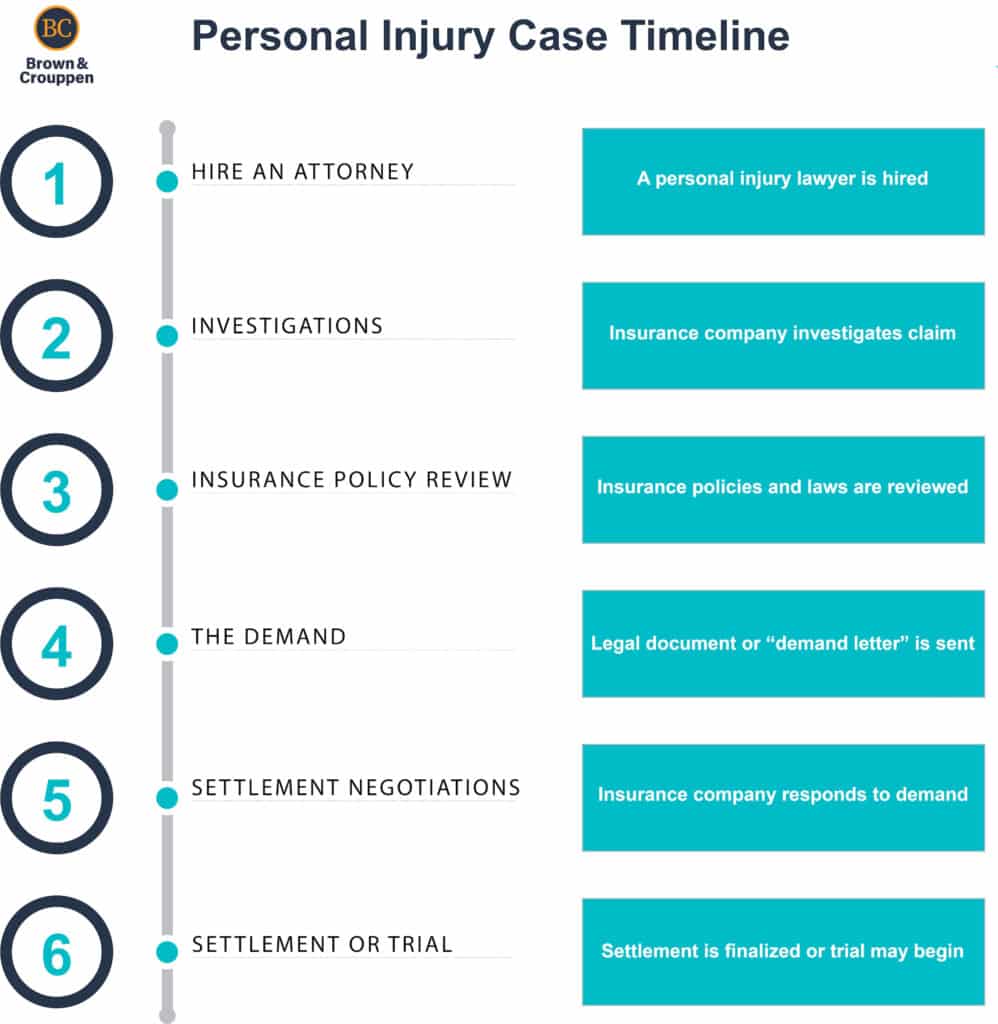
1. HIRING AN ATTORNEY
Not every case warrants the involvement of an attorney. At Brown & Crouppen Law Firm, the very first step is understanding your circumstances and gathering facts about your accident. This is accomplished during your free consultation, which can be completed via in-person meeting, phone call, text message, filling out the Free Case Review form, or using our online chat. If your case would benefit from the involvement of an attorney, we provide you with information about how an attorney can help, including the proper gathering of evidence, documentation, and handling of a claim.
If after your initial consultation an attorney finds your legal situation complicated enough to warrant legal representation, the next step is signing a contract, which officially creates the attorney-client relationship and documents your agreement to have the attorney represent you. Your attorney will then explain the nature of the attorney-client relationship to you, their obligations to you as a client, their fees, and what initial documentation they need from you.
2. INVESTIGATIONS
Once you’ve obtained an attorney, they will ask you for all documentation in your possession relating to your accident, including pictures of the accident scene, property damage pictures, pictures of your injuries, any medical records and/or receipts for medical treatment, etc. if you didn’t already provide it at your initial consultation.
Additionally, your attorney will investigate all facts initially available to them at this time to understand the mechanism of your injury, the extent of your injuries, the damages, and the costs. This also concludes initiating contact with the insurance company that insures the party who injured you and, if the other party has hired an attorney, initiating contact with them as well. While all of this is going on behind the scenes, all you should be concerned with is getting the medical attention you need, complying with any medical treatment plans as recommended by your providers, and keeping your attorney informed about the medical treatment you are receiving. Your focus during this time should be healing and aiming to get back to your pre-accident status while your attorney handles the investigation.
3. SETTLEMENT DEMAND
As mentioned above, not all cases go to trial. Trial is seen as a last resort that is only necessary when the parties cannot come to an agreement. This is because trials are time-consuming, expensive, and mentally exhausting for all parties involved. Additionally, once a controversy reaches the trial phase, a jury decides whether you should be awarded money and how much. Accordingly, the desire to avoid going to trial motivates both parties to reach a private settlement agreement outside of the courtroom.
Once the appropriate evidence is gathered to make your case, your attorney will send a demand letter to the at-fault party, their insurance company, or their attorney if they’ve obtained one. A demand letter basically explains how you were injured in the accident, the damages you sustained as a result of the accident, and how it has affected your life; it also demands that the at-fault party should pay for the injuries that they caused you and notifies the insurance company that failure to reach an agreement will likely result in the filing of a lawsuit. After the demand letter is sent, the attorney will negotiate with the at-fault party’s insurance company. If the insurance company makes a settlement offer, your attorney will notify you and give you their professional opinion regarding whether the settlement offer is reasonable. However, at the end of the day, after considering the attorney’s advice, you ultimately make the decision regarding whether to accept the settlement amount.
Having a lawyer to help with negotiations and how a lawyer negotiates a settlement can have a tremendous impact on the outcome of a case.
4. FILING A PERSONAL INJURY LAWSUIT
If after fiercely negotiating with the at-fault party, the parties cannot agree on an adequate settlement amount, your attorney may decide to file a lawsuit in court. The initiation of a lawsuit begins with filing a “Complaint” or a “Petition,” and you, as the injured party, are now referred to as the “Plaintiff.” This is the very first document filed with the court, which is then served (delivered to) the at-fault party, who now becomes the “Defendant.” This document contains all of the allegations of your claim, the mechanism of your injury, the nature of your injuries, the damages you sustained, and why the Defendant should be liable to you according to the laws of your state.
If the Defendant hasn’t done so already, receiving notice of the formal complaint should prompt them to hire an attorney of their own because they must respond and file an answer to your Complaint within a certain amount of time – usually 30 days. In their Answer, the Defendant will admit or deny the allegations in the Complaint and assert defenses for why they shouldn’t be liable for the accident or shouldn’t be responsible for paying for your injuries.
After the lawsuit is filed, a judge will set a deadline for each stage of the process. However, be aware that either attorney can ask the court for leave to move deadlines around for reasons that may be beneficial to their client’s case, such as needing more time to gather records or interview witnesses. For this reason, the lawsuit process can take anywhere from several months to several years depending on the complexity of your claim and the volume of evidence that needs to be gathered.
5. PRETRIAL
After initial court documents are filed, the parties will engage in discovery. Discovery is the evidence-gathering process, which entails taking depositions (questioning witnesses and parties involved under oath in front of a court reporter), requesting documents, interrogatories (written questions submitted to each party), and interviewing other witnesses/third parties who may have knowledge about the facts of your accident.
Before trial, the parties will also file motions – formal requests to the court to take actions in favor of each party. Motions dictate what each party is permitted and prohibited to do in the pre-trial process. For example, a motion can be filed asking the court to protect your privacy and prohibit the Defendant from investigating any records that have nothing to do with your personal injury claim.
At any time during the lawsuit process, the parties may request mediation: an alternative dispute resolution that involves both parties, their attorneys, and a neutral third party to act as the literal middleman, or referee, between the negotiating parties. The mediator is someone with legal expertise who can advise both parties in private about the pros and cons of reaching a settlement. This is another method of reaching an out-of-court settlement without having to proceed with the formalities of trial before a jury.
6. TRIAL
If, after all of the discovery has been conducted, motions have been filed back and forth, and mediation did not produce an adequate settlement, your case may go to trial. Your attorney will keep you informed in the days leading up to trial about what to expect, courtroom etiquette, and how the trial process works. The typical trial process consists of jury selection, opening statements, witness testimony, cross-examination (questioning live witnesses), closing arguments, jury deliberation, and entering a verdict.
At trial, your attorney will put forth the facts of your case before the judge or a jury using evidence gathered during your case and witness testimony. Then, the defense will present their case and argue why they should not be liable for your injuries. After both sides have made their arguments, the judge or jury will determine whether the defendant should be liable for your injuries, and, if they are, what award you are entitled to.
7. POST TRIAL
If a judge or jury reaches a verdict in your favor, the attorney is required to first pay any liens (assertions by anyone who has a legal claim to your monetary award such as medical providers who have not been fully paid for rendering treatment). After liens, the attorney’s fees, and case expenses are paid, a final check will be remitted to you as payment. Receipt of the award confirms the lawsuit has finally been resolved.
However, be aware that even after trial, both parties may have the opportunity to file an appeal claiming an error in your trial and asking a higher court to reconsider the outcome. Each state has its own specific rules that attorneys are required to follow and comply with during trial. If one party believes that a rule was not followed or a judge ruled improperly, they may file an appeal. If your attorney thinks there is a basis for an appeal, they will explain to you what that process looks like.
GET HELP FROM A PERSONAL INJURY ATTORNEY
The very first step is determining whether your case is complex enough to require the help of an attorney, and that starts with your initial consultation.
Complete your free consultation by calling us, texting us, filling out the Free Case Review form, or using our online chat. We’ll work with you to make the process easy and accessible no matter where you are or what type of device you’re using. Our investigators are here to make the process work for you. We can meet you on your terms, whether that means virtually, at home, or in your other preferred location.
At Brown & Crouppen, we fight for you, and we fight to win. With more than $1 billion awarded and thousands of people helped, our team is dedicated to getting you and your loved ones the justice you deserve.



